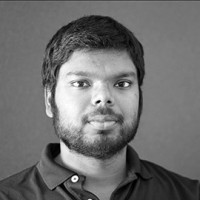main content begins

Professor Suresh Sivanandam is the Director of the Dunlap Institute for Astronomy & Astrophysics. Sivanandam is also an Associate Professor and former Postdoctoral Fellow at the Dunlap Institute and the University of Toronto’s David A. Dunlap Department of Astronomy & Astrophysics. He studies the formation and evolution of galaxies in clusters. One focus of his research is a cluster’s halo of gas and how it interacts with the gas in individual galaxies.
Another is a spectroscopic survey of nearby galaxies to see if their stellar populations differ significantly from predictions. The survey will be conducted with a unique instrument Sivanandam and his collaborators built. The Wide Integral-Field Infrared Spectrograph, or WIFIS, saw first light in 2017 on the 2.3-metre Bok Telescope at the Steward Observatory in Arizona.
In addition to WIFIS, Sivanandam is a key member in many instrument projects, including a Micro-Shutter Array, Multi-Object Spectrograph, or MSAMOS. He is Principal Investigator for near-IR Arctic sky brightness measurements.
And he is leading the development of the Gemini Infrared Multi-Object Spectrograph, or GIRMOS, an infrared spectrograph for the Gemini Observatory, designed to produce high angular-resolution and highly sensitive infrared images of the sky.
Research:
In September 2017, Sivanandam was interviewed about the role the Dunlap and U of T played in advancing his career:
What were the highlights for you as a Fellow at the Dunlap Institute?
I was able to be involved in cutting-edge instrumentation development, such as WIFIS. WIFIS was the first major infrared instrument constructed by the University of Toronto in-house. I worked on that instrument from end-to-end, which gave me a very comprehensive view of what it takes to build a complex instrument and design the scientific programs it would carry out. I also worked with faculty here to develop and apply for funding for new instrumentation concepts that would address scientific questions that could not be tackled with existing instruments.
The Institute provided the resources for myself and another Dunlap fellow, Nick Law, to embark on a high-risk, high-reward project to deploy instruments in the Canadian High Arctic. This was a lot of fun and it exposed us the logistical complexities of deploying instruments and doing science at 80 degrees North.
I had the opportunity to be on the ground-floor of the Dunlap Introduction to Astronomical Instrumentation Summer School, in which I’ve been an instructor since its inception. It provided me an opportunity to share my enthusiasm for astronomical instrumentation with the up-and-coming generation of astronomers.
What drew you to U of T and Dunlap?
When I was considering the Dunlap and U of T, the institute was very new. I was drawn by its mandate to push boundaries in astronomical instrumentation, which matched my own interests. Given that it was still in the process of being formed, I felt that I could help build its future. And being a Canadian, I was also happy to return to my home country to continue my work.
How was your stay at Dunlap helpful in your advancement into your current position?
Being a Fellow, I learned how to develop my own independent research program, which has been immensely helpful for my career. Given that the Institute was very young when I joined, I had the opportunity to be a strong influence in its direction, which helped develop my leadership skills. For example, I was given the opportunity to develop a talk series that brought in local and international experts to discuss the latest developments in astronomical instrumentation.
Dunlap’s outreach events truly exposed me to public engagement and highlighted their importance. From talks to events like Astronomy on Tap T.O., I have discovered how critical it is communicate the work that we do to the general public.
As an organization, what would you say are Dunlap’s strengths?
One of the main strengths is its fellowship program. The Fellows are the heart and soul of the Institute. They are well-nurtured and are very productive. It has been an honour to get to know them and work with them. If I were to pick one other strength, it would be the institute’s financial resources. Dunlap is able to make small investments that can bring about huge returns. I think this is especially important in astronomical instrumentation where new developments can have an immense impact, but they often require some investment to come to fruition. One great example would be providing seed money for the Dragonfly project, which has now expanded to an immense scale.